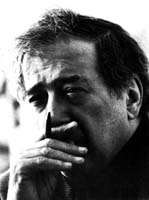|
|
Luciano Berio
Gavin Thomas introduces the work of Luciano Berio (1925–2003).
Overview
Luciano Berio's work is characterised above all by his love of the theatrical,
his fascination with the voice, and his constant willingness to engage with music of the past as well
as of the present.
Drawing on a range of influences that reaches from the poetry of Dante to the
politics of Martin Luther King, and from the operas of Monteverdi to the
sounds of modern jazz, his output has embraced all the major musical developments of its
time, including electronic music, music theatre, and works using quotation and collage – hence one
critic's description of him as an "omnivore".
Berio's leaning towards vocal music was fostered by his relationship with the remarkable
American singer Cathy Berberian, for whom he wrote many
of his earlier works, and whose vocal versatility and charismatic stage presence
was richly exploited in works such as Recital1 – a piece depicting the
nervous breakdown of a neurotic concert singer – Sequenza III, with its surreally dramatic
(if largely unintelligible) stream of sung, muttered and garbled phonetic fragments, and
(in a very different vein) the engaging Folk Songs,
a compendium of folk tunes from around the world which has proved Berio's most
popular work.
At the same time as he was composing his Berberian-inspired vocal pieces, Berio was also
exploring more complex interactions of music and text in three major
works of the 1960s: Épiphanie (1962), Laborintus 2 (1965) and Sinfonia (1969).
Épiphanie sets words by Proust and Brecht (among others) in a variety of vocal
styles ranging from the extravagantly ornamented to the monotonously spoken,
while Laborintus 2 uses speaker, singers, orchestra and jazz musicians to
explore a welter of texts organized around the poetry of Dante.
Most extraordinary of all, however, is the third movement of Sinfonia,
which constructs a musical and verbal labyrinth around the third movement of
Mahler's Symphony No. 2 and passages from
Samuel Beckett's The Unnameable.
The quasi-theatrical Sinfonia was quickly followed by the first of Berio's
four operas.
The first of these works, baldly entitled Opera (1970), is one of Berio's less
successful achievements, but in his three subsequent operas, La vera storia (1981),
Un re in ascolto (1984) and Cronaca del Luogo (1999),
Berio has achieved a remarkable synthesis of extended theatrical techniques
and large-scale musical means.
Admittedly, it's one which owes little to traditional operatic models, concentrating
instead on a staged representation of the musical and textual labyrinths which
were so striking a feature of Sinfonia, as in Un re in ascolto
(A King Listens, with a libretto by Calvino), an opera about the
rehearsals and auditions for an opera – not so much a musico-dramatic
story as an extended meditation on the meaning of listening, singing and memory.
The interleaved musical and verbal texts which characterize so
many of Berio's vocal and theatrical works find their counterpart in
much of his purely instrumental works.
In 1958 he embarked on the sequence of pieces for solo instruments,
the Sequenzas, whose sometimes
zany virtuosity offers an instrumental parallel to the Berberian
vocal works.
These were followed by a further series of linked works,
the Chemins, in which the existing
Sequenzas are recycled within new layers of musical accompaniment
and commentary, rather as the third movement of Sinfonia had supplied
fresh layers of musical and verbal commentary around the kernel of Mahler's
symphonic movement.
A similar preoccupation with recomposition and "commentary techniques" can
be found in Berio's rich sequence of (mainly instrumental) works
based on popular and folk music.
Though this interest dates back to the Berberian Folk Songs of 1964,
it was in instrumental works of the 1970s and 1980s that this
aspect of his music became especially important, most memorably in
Voci (1984), a haunting reworking
of Sicilian folk melodies for viola and orchestra, and
Ritorno degli snovidenia (1977),
based on fragments of Russian revolutionary songs, for cello and orchestra.
Berio's constant dialogue with musical tradition
can also be seen in his various orchestrations of works by
de Falla, Mahler
and Brahms, among others, and, most notably, in
Rendering (1989),
his typically creative completion of unfinished symphonic sketches by Schubert.
Article and review pages originally published in The Rough Guide
to Classical Music
|